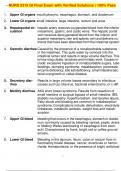NURS 5315 GI Final Exam with Verified Solutions | 100% Pass 1. Upper GI organs mouth,pharynx, esophagus, stomach, and duodenum 2. Lower GI organs small intestine, large intestine, rectum and anus 3. Hepatoportal cir- culation hepatic artery receives oxygenated blood from the inferior mesenteric, gastric, and cystic veins. The hepatic portal vein receives deoxygenated blood from the inferior and superior mesenteric vein and splenic vein and delivers nu- trients that have been absorbed from the intestinal system 4. Osmotic diarrhea Caused by the presence of a nonabsorbable substance in the intestines. This pulls water by osmosis into the intestinal lumen and results in large volume diarrhea. This is how mag citrate, lactulose and miralax work. Causes in- clude: excessive ingestion of nonabsorbable sugars, tube feedings, dumping syndrome, malabsorption, pancreatic enzyme deficiency, bile salt deficiency, small intestine bac- terial overgrowth or celiac disease 5. Secretory diar - rhea Results in large volume losses secondary to infectious causes such as rotavirus, bacterial enterotoxins, or c-diff. 6. Motility diarrhea AKA short bowel syndrome. Results from resection of small intestine or surgical bypass of small intestine, IBS, diabetic neuropathy, hyperthyroidism, and laxative abuse. Fatty stools and bloating are common in malabsorption syndrome. Complications include: dehydration, electrolyte imbalance, metabolic acidosis, weight loss and malab - sorption. 7. Upper GI bleed bleeding that occurs in the esophagus, stomach or duode - num commonly caused by bleeding varices, peptic ulcers or Mallory -Weiss tear(tearing of esophagus from stom - ach) Characterized by frank, bright red or coffee ground emesis. 8. Lower GI bleed Bleeding in the jejunum, ileum, colon or rectum from in - flammatory bowel disease, cancer, diverticula or hemor - rhoids. Hematochezia, or the presence of bright red blood NURS 5315 GI Final Exam with Verified Solutions | 100% Pass 9. Peptic Ulcer Dis- ease in the stools, suggest a lower GI bleed usually in the rectum, sigmoid colon or descending colon Is a break in the integrity of the mucosa of the esophagus, stomach or duodenum resulting in exposure of the tissue to gastric acid. Risk factors include smoking, advanced age, NSAID use, ETOH, chronic disease, acute pancre - atitis, COPD, obesity, socioeconomic status, gastrinoma, and infection with Helicobacter pylori. S&S: Epigastric pain is worse with eating, melena or hematemesis 10. Duodenal ulcers most common and tend to develop in younger patients. S&S: epigastric pain that is relieved by food. Patients may have melena(black and tarry stool) or hematemesis 11. Ulcerative colitis (UC) Inflammatory disease of the large instestine in persons 20-40y/o. Less common in people who smoke. Has pe - riods of remission and exacerbations. Characterized by inflammation and ulcerations that remain superficial and in the small intestine. 12. UC S&S recurrent diarrhea, bloody stools, febrile, polyarthritis, uveitis, sclerosing cholangitis, erythema nodosum and py- oderma gangrenosum 13. UC complica - tions fissures, hemorrhoids, perirectal abscess, toxic mega - colon, colon perforation, and colorectal adenocarcinoma. Increased risk of VTE and microthrombi, and colon cancer 14. Crohn's disease Chronic inflammatory disorders that can affect any portion of the GI tract but most often in the ileum and proximal colon. Affects persons in their 20-30s and of jewish decent. CARD15/NOD2 gene mutation commonly associated. 15. Crohn's disease risk factors 16. Crohn's disease patho smoking, family history, Jewish decent, age less than 40, slight predominance in women and altered gut microbio - me. includes trasmural involvement of the affected area(entire wall of intestine is affected) and the presence of skip




